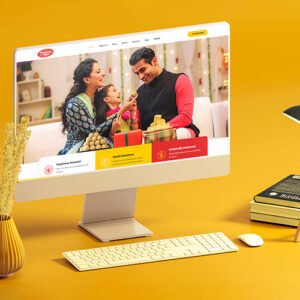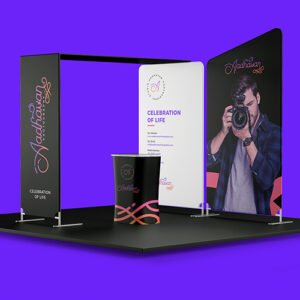Category: Uncategorised
The Role of Typography in Graphic Design: Choosing the Right Fonts
Typography plays a crucial role in graphic design, as it encompasses the art and technique of arranging type to make written language legible, readable, and visually appealing. Choosing the right fonts is essential because they can convey emotions, set the tone, enhance the message, and create a cohesive design. Here are some key considerations when selecting fonts for graphic design:
Readability:
The primary function of typography is to communicate effectively. Therefore, it’s crucial to choose fonts that are legible and easy to read, especially when used in longer texts or smaller sizes. Fonts with clear letterforms and well-defined characters generally offer better readability.
Purpose and Tone:
Different fonts evoke different emotions and set the tone for the design. Consider the purpose and intended message of the project. Is it formal or informal? Playful or serious? The font should align with the desired tone. For example, a script font might be suitable for an elegant wedding invitation, while a bold sans-serif font can convey a modern and confident vibe.
Hierarchy and Contrast:
Typography helps establish a visual hierarchy within a design. Use different font styles, weights, and sizes to create contrast and guide the viewer’s attention. Headlines, subheadings, and body text should have clear distinctions, making it easier for readers to navigate and comprehend the content.
Consistency and Branding:
Typography plays a significant role in establishing and maintaining brand identity. Consistency in font choices across various design materials fosters recognition and reinforces the brand’s personality. Select fonts that align with the brand’s values and overall visual identity.
Pairing and Combinations:
Fonts often work better together in pairs or combinations. Aim for contrast and harmony when selecting complementary typefaces. Combining a serif font with a sans-serif font, for example, can create an interesting and balanced composition. Experiment with different combinations to find the right balance for your design.
Consider Context and Medium:
Fonts can behave differently depending on the context and medium of the design. Consider the final output, whether it’s print or digital, and how the font will render on different devices and screen resolutions. Some fonts may be better suited for body text in print, while others may work well for headlines on a website.
Avoid Overuse:
While there are thousands of fonts available, it’s important not to overuse them. Limiting the number of fonts in a design promotes visual coherence and prevents the overall design from becoming cluttered or distracting. Stick to a select few fonts that work well together and serve the design’s purpose.
Ultimately, choosing the right fonts in graphic design requires a thoughtful approach that takes into account the project’s purpose, audience, tone, and brand identity. By considering these factors and experimenting with different combinations, designers can create visually engaging and impactful design.
The Psychology of Color in Graphic Design: Creating Emotional Connections.
The psychology of color in graphic design refers to the study of how different colors evoke specific emotional and psychological responses in viewers. Colors have the power to influence our emotions, perceptions, and even behavior, making them a vital tool in graphic design to create impactful and meaningful visual communication.Here are some commonly associated emotions and psychological responses to various colors:
Red
Red is often associated with energy, passion, and excitement. It can also convey a sense of urgency or danger. Red can stimulate appetite and create a sense of urgency, making it suitable for food and retail industries.
Blue
Yellow
Yellow is associated with happiness, optimism, and warmth. It can grab attention and create a sense of cheerfulness. Yellow is often used in branding related to youthfulness, creativity, and fun.
Green
Purple
Purple is often associated with luxury, royalty, and creativity. It can evoke a sense of mystery, sophistication, and spirituality. Purple is frequently used in beauty, fashion, and artistic industries.
Orange
Orange combines the energy of red and the cheerfulness of yellow. It represents enthusiasm, warmth, and excitement. Orange is often used to grab attention and create a sense of vitality and friendliness.
Pink
Pink is often associated with femininity, tenderness, and romance. It can evoke feelings of playfulness, sweetness, and nurturing. Pink is commonly used in industries related to beauty, fashion, and products targeting women.
When creating visual designs, graphic designers often consider color theory and the desired emotional response to effectively communicate a message. They utilize color combinations, contrast, saturation, and other design principles to create harmonious and emotionally impactful designs that resonate with the intended audience.
Mastering the Basics: A Beginner’s Guide to Graphic Design
Graphic design is a creative field that involves the visual communication of ideas and messages using typography, images, colors, and various design elements. Whether you’re interested in designing logos, brochures, websites, or social media, graphics, mastering the basics of graphic design are essential. Here’s a beginner’s guide to help you get started.
Understand the Principles of Design:
Familiarize yourself with the fundamental principles of design, such as balance, contrast, hierarchy, alignment, and repetition. These principles provide a foundation for creating visually appealing and harmonious designs.
Get Inspired:
Explore the work of established graphic designers and study various design styles and trends. Look for inspiration in books, magazines, online platforms, and art exhibitions. Develop an eye for design by analyzing what makes certain designs effective.
Learn Design Software:
Familiarize yourself with industry-standard design software such as Adobe Photoshop, Illustrator, and InDesign. These tools are widely used in the graphic design field and offer a wide range of capabilities for creating and manipulating visual content.
Typography Matters:
Typography plays a crucial role in graphic design. Learn about different font types, font families, and how to combine them effectively. Experiment with typography to create hierarchy, emphasis, and visual interest in your designs.
Color Theory:
Understand the basics of color theory and its impact on design. Learn about color schemes, such as complementary, analogous, and monochromatic, and how to use them to create visually pleasing combinations. Consider the psychological effects of different colors and their meaning in various contexts.
Grids and Layouts:
Develop an understanding of grids and layouts to organize and structure your designs effectively. Grids help maintain consistency and provide a framework for placing elements on a page. Experiment with different grid systems to achieve balance and visual harmony.
Use Visual Hierarchy:
Establish a clear visual hierarchy in your designs to guide viewers’ attention and communicate messages effectively. Emphasize important elements using size, color, contrast, and placement. Create a logical flow that guides the viewer’s eye through the design.
Understand Composition:
Composition refers to how different design elements are arranged within a visual space. Learn about the rule of thirds, symmetry, asymmetry, and other composition techniques. Practice creating balanced and visually appealing compositions.
Develop Your Design Process:
Establish a design process that works for you. This typically includes understanding the client’s requirements, brainstorming ideas, creating sketches or wireframes, refining the design, and delivering the final product. Iteration and feedback are essential components of the design process.
Seek Feedback :
Share your work with fellow designers, mentors, or online communities to receive feedback and constructive criticism. Critiques help you identify areas for improvement and gain new perspectives on your designs. Embrace feedback as an opportunity to grow and refine your skills.








